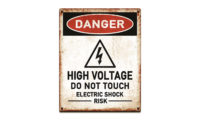OSHA authorized the National Fire Protection Association, or NFPA, to develop the 70E standard in 1976 due to the sheer numbers of lives lost due to electrocution and arc flash incidents. Though the exact numbers of injuries and deaths from electrocution and arc flash are unknown due to inconsistencies in reporting, the U.S. Department of Labor estimates that combined, they result in over 400 fatalities and nearly 10,000 serious injuries each year. Arc flash incidents alone are estimated to occur 5 to 10 times each day, resulting in a fatality every workday. Contact with energized electrical components is the 4th leading cause of death in construction and represents 9 percent of all construction-related fatalities.
With so many deaths occurring annually, it would appear that the estimated 10,000 or more survivors of electrical shock and arc flash incidents represent the “lucky ones”… if you consider living with severe scaring, disfigurement, dismemberment, blindness, hearing loss and a host of other permanently disabling injuries “lucky.”
Few would disagree that the statistics above are unacceptable and improvements must be made. But what can we do to change this trend? Root cause analysis has shown that the most common cause of electrical incidents is the failure to understand, train, implement, comply with and/or enforce the safe work procedures detailed in 70E.
Though 70E is designed to protect personnel who work in and around electrical systems and equipment, it can only be effective when programs are implemented and employees are trained and audited for compliance. Below is a short overview of some critical components and requirements of 70E and some best practices industry leaders utilize to protect both their employees and contractors:
Electrical safety program:
- Ensure you have an effective Electrical Safety Program that meets or exceeds NFPA 70E requirements.
- Ensure electrically safe work conditions:
- Perform all work de-energized by following control of hazardous energy procedures such as lockout/tagout.
- Identify all possible sources of electrical supply to the equipment by checking up-to-date drawings, diagrams and identification tags
- Use an adequately rated voltage detector to verify zero energy.
- Work involving energized electrical hazards:
- Energized electrical work requires a documented justification from management that details a “compelling reason” why the work must be done energized.
- Compelling reasons fall into the following three categories:
1. Greater hazards - Those hazards where the employer can demonstrate that de-energizing the electrical systems will produce increased risks and/or hazards. Examples could include power to hospitals, life support systems or other examples where life or safety depends on uninterrupted electrical power.
2. Infeasibility - Those situations where an employer can demonstrate that the task to be performed is infeasible in a de-energized state due to equipment design or operational limitations
3. Less than 50 volts - Where energized work would be performed on systems that operate at less than 50 Volts.
Even with safeguards in place, energized electrical work puts workers at risk and the decision to perform electrical work “energized” should always be the last option on the table. Many companies utilize a policy that requires executive management to approve energized electrical work and puts the responsibility for such a critical decision at the right level in the organization.
Hazard identification & risk assessment
Safe work practices must be designed for the work to be performed with the intent of safeguarding all employees exposed to energized electrical hazards. Work practices that are used shall be suitable for the conditions under which the work is to be performed and for the voltage level of the energized electrical conductors. NFPA 70E requires that these Safe Work Practices be effective and determined before anyone is exposed to the electrical hazards. The tools used to develop these safe work practices and controls are called the Shock Hazard Analysis and Arc Flash Hazard Analysis.
Shock hazard analysis
The shock hazard analysis is a process in which the Limited Approach Boundary, the Restricted Approach Boundary, and the Prohibited Approach Boundary are identified. The size and distance of each approach boundary is 100-percent dependent on the voltage levels of the exposed electrical components.
The Limited Approach Boundary is the distance from an exposed energized electrical conductor or circuit part within which a shock hazard exists. Only Qualified Persons and escorted unqualified persons are allowed within the Limited Approach Boundary.
The Restricted Approach Boundary is the distance from an exposed energized electrical conductor or circuit part within which there is an increased risk of shock for personnel working in close proximity to the energized electrical conductor or circuit part.
The most dangerous and highest hazard of all approach boundaries is the Prohibited Approach Boundary and is considered the distance from an exposed energized electrical conductor or circuit part within which work is considered the same as making actual contact with the electrical conductor.
Arc flash analysis
An arc flash hazard analysis is used to determine:
- The Arc Flash Boundary
- The Incident Energy at the Working Distance, and
- The required PPE to protect personnel from the identified hazards.
Annex D of NFPA 70E contains the calculation methods for determining incident energy and arc flash boundaries. It is recommended that an experienced electrical engineer, electrical safety consultant or other qualified entity conduct the Arc Flash Analysis for your equipment. The safety of your personnel or facility is dependent on the results of the analysis being accurate.
Equipment labeling
Electrical equipment must contain labels that clearly state one of the following:
- The Available Incident Energy and the corresponding working distance, or
- The minimum rating of clothing required, or
- The required level of PPE required, or
- The Highest Hazard/Risk Category for that specific piece of equipment.
In addition, the label must include the Nominal System voltage and Arc Flash Boundaries. Labels applied before September 30, 2011, are acceptable only if they contain the available incident energy or required PPE.
Compliance
NFPA 70E provides industry-proven safety systems and processes that help companies protect their employees from arc flash hazards, and if followed completely, compliance with OSHA requirements. Implementation, training, enforcement and auditing for compliance are all equally important and required components of an effective Electrical Safety Program. Though OSHA does not dictate the use of NFPA 70E specifically, it does require employers to use industry standards and practices that will protect their workforce from harm, and NFPA 70E is recognized as the reference document for workplace electrical safety.



